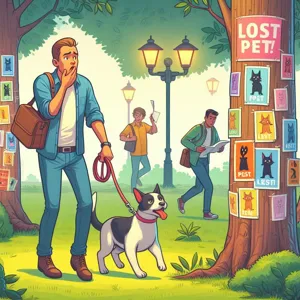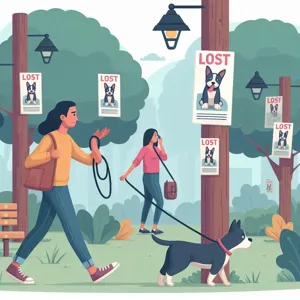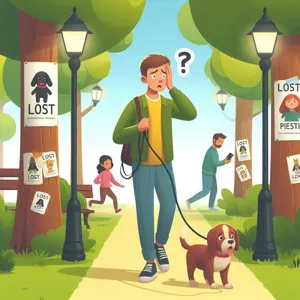For dog owners, the joyful sound of a wagging tail and playful barks can quickly turn into a source of frustration when excessive barking disrupts the peace of your home and neighborhood.
While barking is a natural form of communication for dogs, incessant noise can signal underlying issues such as anxiety, boredom, or a lack of proper training. Understanding the reasons behind your dog’s vocalizations is key to addressing the problem effectively. In this blog post, we’ll explore practical and humane strategies to help you curb your dog’s excessive barking, allowing you to foster a calmer environment for both you and your furry friend. From identifying triggers and implementing training techniques to creating a stimulating atmosphere, these tips will empower you to manage your dog’s barking and enhance your cherished bond. Say goodbye to sleepless nights and hello to tranquility as we dive into the world of canine communication!
1. Understanding the Reasons Behind Excessive Barking

Before you can effectively curb your dog’s excessive barking, it’s essential to understand the motivations behind their vocalizations. Dogs bark for a variety of reasons, each rooted in instinctual behaviors and environmental triggers. By identifying the specific cause of your dog’s barking, you can tailor your approach to address the root of the issue rather than merely silencing them.
One common reason dogs bark excessively is to communicate. This could be their way of expressing excitement when a family member arrives home, or it may be a signal of distress when they are left alone. In some cases, barking serves as an alert mechanism, warning you of perceived threats or unusual happenings in their surroundings. This protective instinct can be particularly strong in certain breeds, leading them to bark at anything that moves—be it a squirrel passing by or a neighbor walking their dog.
Another factor to consider is boredom or lack of exercise. Dogs are energetic creatures that require physical and mental stimulation. An under-stimulated dog may resort to barking as a way to release pent-up energy or to seek attention. This is especially true for high-energy breeds that thrive on activity and engagement.
Additionally, fear or anxiety can trigger excessive barking. If your dog is frightened by loud noises, unfamiliar environments, or the presence of strangers, they may bark as a way to cope with their anxiety. Understanding your dog’s body language during these episodes can provide insight into their emotional state, allowing you to address any fears or insecurities.
Finally, some dogs develop a habit of barking due to learned behaviors. If barking has consistently resulted in attention—whether positive or negative—your dog may learn to use it as a tool for communication. This is where consistent training and reinforcement become crucial in breaking the cycle.
By taking the time to observe your dog’s barking patterns and understanding the motivations behind them, you can create a more effective strategy to reduce excessive barking. Once you pinpoint the cause, you can implement targeted solutions, leading to a more peaceful environment for both you and your furry companion.
2. Assessing Your Dog’s Barking Triggers
Understanding the reasons behind your dog’s barking is the first crucial step in curbing this behavior. Every dog is unique, and their barks can be influenced by a myriad of factors—ranging from environmental stimuli to emotional states. Begin by observing your dog closely. Keep a journal to note the specific situations that trigger barking. Is it the sound of the mailman arriving? The sight of other dogs passing by? Or perhaps it’s when someone rings the doorbell or when they hear unfamiliar noises outside?
Take note of the context: what time of day does the barking occur? How does your dog’s body language change when they bark? For example, if your dog barks and stands rigid by the window, they may be reacting to something they see outdoors, indicating a territorial instinct. Conversely, if they bark while wagging their tail or jumping around, it could be a signal of excitement or playfulness.
Also, consider the frequency and intensity of the barking. Is it a sharp, high-pitched bark that suggests anxiety or fear, or is it a low, steady bark that seems more like a warning? Identifying whether the barking is motivated by boredom, fear, excitement, or a desire for attention is essential in figuring out the most effective response.
Once you’ve gathered this information, you’ll be better equipped to address the root causes. For instance, if your dog barks out of boredom, implementing more physical exercise and mental stimulation can help alleviate the behavior. If it’s fear-based, creating a more secure environment or desensitizing your dog to the specific triggers could be the key. By thoroughly assessing your dog’s barking triggers, you can tailor your approach and set both you and your furry friend on the path to a quieter, more harmonious home.
3. The Importance of Training and Socialization

Training and socialization play a crucial role in managing your dog’s barking behavior. Just like humans, dogs thrive on structure and clear boundaries. Establishing a solid training routine not only helps curb excessive barking but also strengthens the bond between you and your furry friend.
Start with basic commands like “sit,” “stay,” and “quiet.” These commands lay the groundwork for good behavior and help your dog understand what is expected of them. Positive reinforcement is key; reward your dog with treats, praise, or playtime every time they respond correctly. This approach not only motivates them to obey but also builds their confidence.
Socialization is equally important. Exposing your dog to different environments, people, and other animals can significantly reduce anxiety and fear—common triggers for excessive barking. Arrange playdates with other dogs, visit pet-friendly parks, or take them on walks in bustling areas. The more experiences your dog has, the more comfortable they will become in various situations, diminishing the likelihood of barking in response to unfamiliar stimuli.
Consistency is vital in both training and socialization. Make sure everyone in your household applies the same commands and training methods. This uniformity reinforces the desired behavior and eliminates confusion for your dog. Over time, with patience and persistence, you’ll notice a marked improvement in your dog’s barking habits, leading to a more harmonious home environment for both you and your beloved pet.
4. Positive Reinforcement Techniques
When it comes to managing excessive barking, positive reinforcement techniques are among the most effective and humane strategies you can employ. This approach focuses on rewarding desired behaviors rather than punishing undesirable ones, creating a positive learning environment for your furry friend. The principle is simple: when your dog remains quiet in situations that would typically trigger barking, you immediately provide a reward. This reward can be a treat, verbal praise, or even a favorite toy—anything that your dog finds motivating.
Start by identifying the specific triggers that lead to your dog’s barking. Is it the mailman approaching your home, the sound of other dogs barking nearby, or perhaps the excitement of seeing other people? Once you know the triggers, you can work on desensitizing your dog to these stimuli. For example, if your dog barks at the doorbell, practice ringing the doorbell while keeping your dog on a leash. When your dog remains calm and quiet, shower him with praise and a tasty treat. Repeat this exercise until your dog begins to associate the doorbell sound with positive reinforcement rather than a reason to bark.
Consistency is key in this process. Make sure everyone in your household is on the same page and uses similar commands and rewards. Over time, your dog will learn that remaining quiet brings more rewards than barking. Additionally, incorporating training sessions into your daily routine will not only strengthen your bond but also provide mental stimulation for your dog, making them less likely to bark out of boredom or frustration.
Remember, patience is essential. Changing behavior takes time, and there may be setbacks along the way. Celebrate the small victories, and keep reinforcing the calm, quiet behavior you want to see. With dedication and love, you can effectively curb your dog’s excessive barking, leading to a more peaceful home for both of you.
5. Implementing the ‘Quiet’ Command

Implementing the ‘Quiet’ command is a powerful and effective strategy to curb excessive barking in dogs. This simple yet essential command can transform the way your furry friend communicates and can lead to a more peaceful home environment.
To begin, it’s crucial to introduce the ‘Quiet’ command in a calm and controlled setting. Choose a time when your dog is likely to bark—perhaps during a delivery at the door or while playing with other dogs at the park. Once your dog starts barking, remain patient and wait for a natural pause in the barking. As soon as they stop, calmly and confidently say “Quiet” in a firm yet gentle tone.
When your dog responds to the command, even if it’s just for a brief moment, reward them immediately with a treat or praise. This positive reinforcement connects the command with a desirable outcome, making it more likely that your dog will respond appropriately in the future. Consistency is key; practice the command regularly, and always be consistent with your tone and rewards.
If your dog continues to bark after the initial command, avoid yelling or showing frustration, as this may inadvertently encourage more barking. Instead, wait for another moment of silence, repeat the command, and reward them once again. Over time, your dog will learn to associate the command with quiet behavior, leading to a significant decrease in excessive barking.
Remember, patience and repetition are vital when teaching the ‘Quiet’ command. With persistence and love, you can help your furry companion understand that sometimes, silence is golden. This command not only enhances communication but also fosters a stronger bond between you and your dog, creating a more harmonious living environment for everyone.
6. Creating a Calm Environment
Creating a calm environment is essential for managing your dog’s barking tendencies. Dogs, like humans, respond to their surroundings, and a serene atmosphere can significantly reduce their urge to vocalize excessively. Begin by evaluating your home for potential stressors that could trigger barking. Loud noises, such as traffic, construction, or even a bustling household, can agitate your furry friend. If possible, try to minimize these disturbances by using soundproofing techniques, such as heavy curtains or noise-canceling devices, to create a quieter sanctuary.
Additionally, consider the layout of your living space. Dogs are naturally curious and may bark at stimuli they can see or hear from windows or doors. You can block their view of distractions by using frosted window film or strategically placing furniture to create a more enclosed area. Incorporating calming elements into your home can also be beneficial. Soft lighting, soothing music, and comfortable resting spots can help your dog feel more at ease.
Moreover, establishing a consistent routine—complete with regular exercise, playtime, and quiet periods—can provide your dog with the structure they crave. A well-exercised dog is less likely to engage in excessive barking out of boredom or pent-up energy. Finally, introduce calming aids such as pheromone diffusers or anxiety wraps, which can promote a sense of security and tranquility. By fostering a peaceful environment, you can help your dog feel secure, reducing their need to bark and creating a more harmonious home for both of you.
7. Providing Enough Physical and Mental Stimulation

One of the most effective strategies to curb excessive barking in dogs is to ensure they receive adequate physical and mental stimulation. A bored dog is often a noisy dog, using barking as an outlet for their pent-up energy. Engaging your furry friend in regular exercise not only promotes their physical health but also helps alleviate stress and anxiety, two common triggers for excessive barking.
Start by establishing a routine that includes daily walks, playtime, and opportunities for exploration. Aim for at least 30 minutes of vigorous exercise each day, adjusting based on your dog’s breed, age, and energy levels. Activities like fetching a ball, agility training, or even swimming can provide a fantastic release for their energy. Not only does this physical exertion help calm your dog, but it also strengthens the bond between you and your pet.
In addition to physical activity, mental stimulation is equally crucial. Dogs thrive on challenges that engage their minds. Invest in puzzle toys that dispense treats, or create scavenger hunts around your home or yard to encourage problem-solving skills. Training sessions that teach new tricks or reinforce commands can also provide mental enrichment while establishing your authority as the leader of the pack.
Remember, a well-stimulated dog is less likely to bark out of boredom or frustration. By integrating a balanced mix of physical and mental activities into your dog’s daily routine, you’ll not only help reduce excessive barking but also foster a happier, healthier, and more content companion.
8. Using Anti-Bark Collars: Pros and Cons
When it comes to managing excessive barking, anti-bark collars can be a controversial yet effective tool for many dog owners. These devices come in several forms—including citronella spray collars, ultrasonic collars, and static correction collars—and each offers a unique approach to curbing your furry friend’s vocalizations. However, before deciding to use an anti-bark collar, it’s vital to weigh both the pros and cons to ensure it aligns with your training goals and your dog’s temperament.
**Pros:**
One of the most significant advantages of anti-bark collars is their ability to deliver immediate feedback to your dog. For many pets, the sensation of a gentle spray, sound, or static correction can be enough to interrupt the barking cycle and signal that excessive noise leads to an unpleasant experience. This swift response can help dogs learn more quickly when to cease barking, particularly in situations where they might feel triggered or overly excited.
Additionally, anti-bark collars can be a convenient option for busy pet owners. With these collars, you can manage barking even when you’re not physically present to intervene. This can be especially useful for dogs that bark at distractions while you’re away from home, providing a degree of peace for both you and your neighbors.
**Cons:**
On the flip side, anti-bark collars are not a one-size-fits-all solution and may not be appropriate for every dog. Some pets may become anxious or fearful of the collar, leading to increased stress or behavioral issues. Additionally, if not used correctly, these collars can reinforce negative associations and make barking a problematic behavior rather than addressing the root cause.
Moreover, anti-bark collars don’t address the underlying reasons for barking. If your dog is barking due to boredom, anxiety, or other behavioral triggers, it’s essential to tackle those issues alongside any collar use. Failing to do so could lead to further frustration for both you and your dog, as they may continue to bark despite the collar being in place.
In summary, while anti-bark collars can be an effective tool for some dog owners, they should be used thoughtfully and in conjunction with a comprehensive training plan. Always consider your dog’s unique personality and needs, and consult with a professional trainer or veterinarian if you have any doubts about incorporating this approach into your barking management strategy. By doing so, you’ll ensure a well-rounded solution that promotes both effective communication and a positive relationship with your furry companion.
9. Desensitization Techniques for Barking Triggers
Desensitization techniques can be a powerful tool in addressing your dog’s excessive barking by gradually exposing them to the stimuli that trigger their vocalizations. The key to success lies in patience and consistency, as this process helps your dog learn to remain calm in the face of their usual barking triggers.
Begin by identifying the specific situations that provoke your dog’s barking. Common triggers include doorbells, passing cars, or other barking dogs. Once you’ve pinpointed these stimuli, you can create a controlled environment where you can manage the exposure. For instance, if your dog barks at the doorbell, have a friend ring the bell while you keep your dog on a leash in a separate room. Start with the volume turned down or use a recording of the doorbell at a low volume, so the sound is just audible but not overwhelming.
As your dog begins to notice the sound without reacting, reward them for their calm behavior with treats and praise. Gradually increase the volume over time, continuing to reward your dog for remaining quiet. This step-by-step approach helps your dog associate the trigger with positive experiences rather than feeling the need to bark excessively.
Incorporating this technique into your training regime not only fosters a sense of security in your dog but also strengthens your bond with them. Over time, as your dog’s confidence grows, they will learn to trust that there’s no need to bark at every little sound, leading to a more peaceful home environment for both of you. Remember, consistency is key, and while it may take time, the results will be well worth the effort.
10. Seeking Professional Help: When to Consult a Trainer
While many dog owners can successfully manage their pet’s barking issues through patience and consistent training, there are times when the situation might feel overwhelming. If you find yourself struggling to curb your dog’s excessive barking despite your best efforts, it may be time to seek professional help. Consulting a dog trainer can provide valuable insights and tailored strategies that address not only the barking but also the underlying causes.
Understanding when to reach out for professional assistance is crucial. If your dog’s barking seems to stem from anxiety, fear, or aggression, a trainer with expertise in behavioral issues can guide you through the process of modification. Additionally, if your dog barks at specific triggers—be it other dogs, strangers, or loud noises—a trainer can help you desensitize your pet to these stimuli, teaching them more appropriate responses.
Look for trainers who use positive reinforcement methods, as these approaches are not only effective but also foster a strong, trusting relationship between you and your dog. A skilled trainer will assess your dog’s behavior in person, allowing them to develop a customized training plan that suits your pet’s unique personality and needs.
Moreover, a trainer can equip you with practical tools and techniques to employ at home, ensuring that you feel confident in managing your dog’s barking long after the training sessions are over. Remember, seeking professional help is not a sign of failure; rather, it demonstrates your commitment to your dog’s well-being and your desire to create a harmonious living environment. Investing in professional guidance can lead to a happier, quieter home and a deeper bond with your furry companion.
11. The Role of Breed Characteristics in Barking
When it comes to understanding your dog’s barking habits, breed characteristics play a significant role. Different breeds were developed for various purposes, and their barking tendencies often reflect their original functions. For instance, herding breeds like Border Collies or Australian Shepherds were bred to communicate with livestock, and as such, they tend to be more vocal. Their instinct to alert and guide can manifest in excessive barking if not properly channeled.
On the other hand, breeds like the Basenji are known as “barkless dogs” because they have a unique vocalization that doesn’t resemble traditional barking. Instead, they produce a sound often described as a yodel, which is a testament to how breed traits can influence vocal behavior. Understanding these inherent tendencies can help you tailor your training approaches.
If you have a breed known for its barking tendencies, such as a Dachshund or a Beagle, it’s essential to consider their natural instincts in your training regime. These breeds may require more structured activities and mental stimulation to curb their barking. Engaging them in interactive games, obedience training, or even agility exercises can provide an outlet for their energy and reduce the likelihood of excessive vocalization.
Moreover, it’s crucial to recognize that some breeds may bark due to anxiety or fear, especially if they are not properly socialized. Take the time to assess your dog’s breed characteristics and individual personality traits. By aligning your training strategies with their natural inclinations, you can create a more harmonious environment where barking is minimized, and your dog’s needs are met. Understanding the interplay between breed characteristics and barking can ultimately strengthen your bond with your canine companion while fostering a quieter home.
12. Managing Separation Anxiety to Reduce Barking
Managing separation anxiety is a crucial step in curbing your dog’s excessive barking. Many dogs bark excessively when left alone due to fear and anxiety, and understanding this behavior is key to addressing it effectively. When your furry friend feels insecure or abandoned, barking becomes their primary method of expressing distress.
To begin, it’s essential to create a positive association with your departures. Start with short absences—just a few minutes at first—and gradually increase the duration as your dog becomes more comfortable being alone. Use engaging toys or puzzle feeders to keep them occupied during your absence, directing their focus away from the worry of being alone.
Training your dog to settle in a specific area while you’re away can also be beneficial. Designate a cozy spot with their favorite blanket or bed, and encourage them to relax there with treats and praise. This way, they learn that your absence doesn’t signal a time for panic but rather an opportunity for a cozy nap.
Additionally, consider incorporating calming aids like anxiety wraps or pheromone diffusers, which can help soothe their nerves. Regular physical exercise and mental stimulation are also vital; a tired dog is less likely to bark out of boredom or anxiety. Engage in daily walks, play sessions, and even training exercises to expend their energy.
Finally, if your dog’s barking due to separation anxiety persists despite your efforts, don’t hesitate to consult a professional dog trainer or a veterinarian. They can provide tailored strategies or recommend behavioral therapies to help your pup feel more secure when left alone. By managing separation anxiety effectively, you not only reduce excessive barking but also foster a deeper bond of trust and security with your beloved companion.
13. The Impact of Routine on Your Dog’s Behavior
Establishing a consistent routine for your dog can be a game-changer when it comes to curbing excessive barking. Dogs thrive on structure and predictability, and a well-defined daily schedule can significantly reduce anxiety and the urge to bark. By creating a routine that includes regular feeding times, walks, play sessions, and quiet time, you provide your dog with a sense of security. This predictability helps them feel more grounded and less likely to bark out of stress or boredom.
For example, if your dog knows that they will be taken for a walk every morning at 8 AM, they are less likely to bark out of excitement or frustration during the day. Similarly, incorporating designated playtime and training sessions can channel their energy into productive activities, leaving less room for unwanted barking.
Moreover, routines can help you identify triggers that lead to barking. If your dog consistently barks at the mailman at the same time each day, you can anticipate this behavior and implement strategies to manage it, such as redirecting their attention with treats or toys during that time.
Consistency is key. The more you stick to a routine, the more your dog will adapt to it, leading to a calmer demeanor. As their anxiety levels decrease, so will their tendency to bark excessively. Thus, a well-structured routine not only enriches your dog’s life but also fosters a peaceful home environment for everyone.
14. Success Stories: Real-Life Examples of Barking Solutions
### 14. Success Stories: Real-Life Examples of Barking Solutions
When it comes to curbing excessive barking, there’s nothing quite as inspiring as hearing real-life success stories. These accounts not only showcase effective strategies but also offer hope to dog owners who are wrestling with the challenges of a noisy pup.
Take, for instance, the story of Bella, a spirited Beagle who would bark incessantly at passing cars, neighborhood cats, and even the mailman. Her owner, Sarah, was at her wit’s end, worried about the growing tension with her neighbors. After researching various techniques, she decided to implement a combination of positive reinforcement and the “quiet” command. Each time Bella barked, Sarah would wait for a moment of silence before rewarding her with a treat. It took patience and consistency, but within a few weeks, Bella learned to associate quiet moments with positive outcomes. Now, she’s a calmer companion who only barks occasionally, and the neighborhood is much happier for it.
Another success story comes from Tom and his German Shepherd, Max. Max had a tendency to bark at anything that moved, from squirrels to fellow joggers. After consulting with a professional dog trainer, Tom learned the importance of providing Max with adequate physical and mental stimulation. He began taking Max on daily runs and introduced interactive toys that kept him engaged. With his energy redirected, Max’s barking diminished significantly. Now, their early morning runs are a highlight of both their days, and their bond has never been stronger.
Lastly, consider the case of Daisy, a Chihuahua who had a habit of barking at strangers entering her home. Her owner, Lisa, recognized that Daisy’s behavior stemmed from fear rather than aggression. To tackle this, Lisa enlisted the help of a desensitization technique. She invited friends over, starting with just one person, and rewarded Daisy for remaining calm. Gradually, Daisy learned that visitors were not threats but rather friends, leading to her newfound tranquility. Lisa’s dedication transformed Daisy into a more confident dog, and their home became a welcoming place for guests.
These success stories highlight that with the right strategies, patience, and commitment, barking problems can be effectively managed. Whether it’s through training, mental stimulation, or addressing underlying fears, each dog is unique, and finding the right solution can lead to a more peaceful environment for both pets and their owners. If you’re struggling with your dog’s barking, remember that change is possible—it just takes a little time and effort.
15. Maintaining Consistency and Patience in Training
Consistency and patience are the cornerstones of successful dog training, especially when it comes to curbing excessive barking. Just like humans, dogs thrive on routine and clear expectations. If your training methods fluctuate or if different family members apply varying rules, your dog can become confused, leading to even more barking. Therefore, establish a consistent training schedule, using the same commands and signals, and ensure that everyone in your household is on the same page. This uniformity helps your dog understand what behaviors are acceptable and which are not.
Patience is equally crucial. Training a dog is not a swift process; it requires time and dedication. Celebrate small victories along the way, and remember that setbacks are a normal part of the learning journey. If your dog barks in response to a particular trigger, take a step back and assess the situation rather than reacting in frustration. Reinforce positive behavior with treats, praise, or playtime, rather than focusing solely on the negative. Over time, your dog will learn that quiet behavior earns rewards, while excessive barking does not.
Additionally, be aware that every dog is unique, with its own personality and learning pace. Some may grasp concepts quickly, while others might need extra time to adjust. By maintaining a calm demeanor and remaining steadfast in your training efforts, you will foster a trusting relationship with your dog. This bond will not only make the training process more effective but also enhance your overall connection, leading to a quieter, happier home for both you and your furry companion.
In conclusion, addressing your dog’s excessive barking can be a rewarding journey that strengthens the bond between you and your furry friend. By implementing the effective strategies outlined in this post, you can create a more harmonious environment for both your dog and your household. Remember, patience and consistency are key—each dog is unique, and finding the right approach may take time. Celebrate the small victories along the way, and soon you’ll be enjoying quieter moments together. We hope these tips empower you to transform barking into a more peaceful coexistence, allowing your dog’s true personality to shine through. Happy training!




































